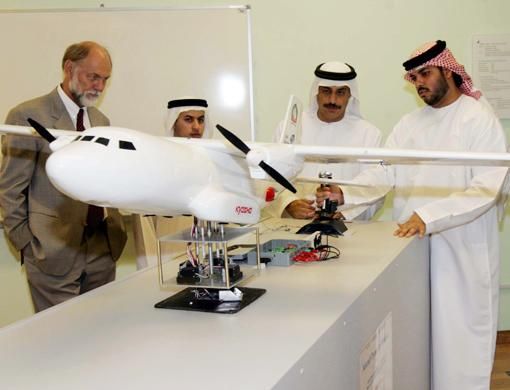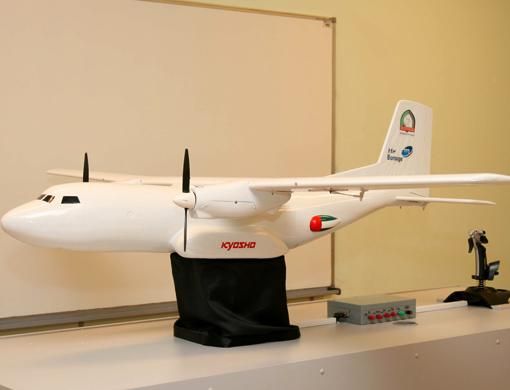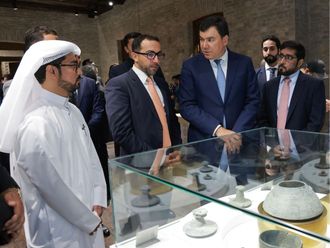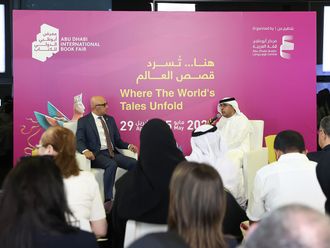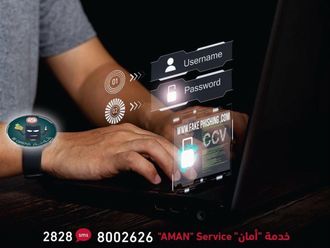Abu Dhabi: Emirati student Ahmad Al Baloushi has built the UAE's first external dynamic simulator for aircrafts, is currently designing a helicopter simulator and will follow that with light reflectors for cars.
As part of a project requirement as an electronics engineer, Al Baloushi designed a C160 Aircraft Simulator but due to its unique features and success, he was encouraged to take part in additional projects.
It took him and another student two semesters to complete the project. Al Baloushi is graduating in June from the Higher Colleges of Technology (HCT).
"Usual plane simulators allow the pilot to be seated in front of a screen and have access to an internal joy stick. With this plane simulator you can see what is happening to the aircraft from the outside," said the student.
The C160 Aircraft Dynamic Simulator resembles a military transport plane. But its shape is similar to that of a civil aircraft.
While Al Baloushi was assembling components of the plane he was seeking advice from pilots about small details such as the use of the Joy Stick Controller. He also did a lot of research on the internet on how to fly aircraft.
"The device is useful in that it can be used for demonstration purposes without the risks involved in a real aircraft. Teachers can train students on how to fly aircraft anywhere they want and with less risk to the student before they proceed to the real aircraft. It can also be used by maintenance and aviation companies for testing new devices before installing them in the aircraft, which will [enable] higher performance," said Al Baloushi.
Since he was a child, Al Baloushi told Gulf News, he enjoyed testing and breaking things, especially electronics. When designing the aircraft simulator, he was thinking that he wanted to create something different, useful and affordable for the UAE.
"Most of our pilots are sent abroad to learn how to fly a plane. With this new simulator that is not necessary anymore," he said.
The helicopter simulator Al Baloushi is working on will be more complicated than an aircraft, since a helicopter needs a smaller area to take off and requires more mechanics and spare parts.
He also plans to create light reflectors for a car.
"Some cars have light reflectors which are mostly evident while parked in side streets during the night to avoid accidents. What I plan to do is add permanent light sensors that can detect any nearby car passing by.
"The sensor is triggered as soon as there is light coming towards another car. The light sensor will be placed in the front part of the car. It's a great way to avoid accidents," said Al Baloushi. He said he was prompted to undertake the light reflector project after witnessing unnecessary road accidents that he claims could be avoided if the right security measures are taken. "I see a lot of accidents nowadays and lots of roads do not have lights. I'm already involved in fin-alising the car project within two to three months. I've been working on it since summer."
Al Baloushi raised Dh15,000 for the plane stimulator project by receiving 33 per cent from Abu Dhabi Polymer Company (Borouj) which sponsored the project and 26 per cent from HCT. The remainder came from his own savings.
Al Baloushi is currently working with Adnoc as a study break. "I plan to continue with Adnoc. I was a technician and once I graduate I will work as a Control Engineer with Borouj. I want to get into the petrol sector, it's a learning environment and I would like to develop multiple skills, I will not focus on one area."
Commercial uses
Besides working as a Control Engineer, he would like to start his own business and work on aircraft. Al Baloushi is confident that a local sponsor or airline will be interested in the project since it is not as expensive as an average simulator which is imported from Europe for over $100,000 (about Dh367,000).
"I already have an offer to work with a Saudi Arabian businessman who proposed to buy the aircraft simulator idea from me under condition that the product would say 'made in Saudi Arabia.' I am still thinking about it, it's a tough decision to make," he told Gulf News.
facts
About the Aircraft Simulator:
The simulator model of the aircraft with action centred surfaces will be kept on a three axis platform to demonstrate the roll, pitch and yaw along with its corresponding centre surface movements - ailerons, elevators and rudder respectively.
Some specifications:
- Wing span 1.830mm
- Weight 2.850mm
- Length 1.350mm
- Wing area 37.5dm
- Wing loading 76g\dm
- Airfoil Torino-26
The airplane has three control surfaces - ailerons, elevators and a rudder. Within the cockpit, two controls operate the control surfaces. The control stick controls the ailerons and elevators. The rudder pedals control the rudders.


